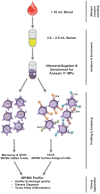Extracellular vesicle profiling and their use as potential disease specific biomarker
- PMID: 25225495
- PMCID: PMC4150251
- DOI: 10.3389/fimmu.2014.00413
Extracellular vesicle profiling and their use as potential disease specific biomarker
Abstract
Cell-derived vesicles in particular extracellular vesicles (EVs) such as microparticles (MPs) and microvesicles besides exosomes are raising more and more attention as a novel and unique approach to detect diseases. It has recently become apparent that disease specific MP signatures or profiles might be beneficial to differentiate chronic liver diseases such as non-alcoholic fatty liver disease and chronic hepatitis C, to monitor their progression or possibly to assess treatment outcome. Therefore EVs might serve as a novel inexpensive and minimally invasive method to screen risk patients for the outbreak of a disease even before the initial symptoms, to follow up treatment complications and disease relapse. The purpose of the current review is to summarize already published EVs signatures for a limited number of exemplary diseases and to discuss their possible impact. Additionally, it will be discussed if the combination of EV profiling and miRNA profiling could be a future joint tool for the purpose of detecting cancer and from far larger interest to ultimately distinguish among various tumor entities. EVs might increase the chance of early detection of chronic diseases or cancers especially if applied as part of yearly health screenings in the future.
Keywords: extracellular vesicles; miRNA; microparticles; microvesicles; profiling.
Figures

References
-
- Sims PJ, Faioni EM, Wiedmer T, Shattil SJ. Complement proteins C5b-9 cause release of membrane vesicles from the platelet surface that are enriched in the membrane receptor for coagulation factor Va and express prothrombinase activity. J Biol Chem (1988) 263:18205–12 - PubMed
Publication types
LinkOut - more resources
Full Text Sources
Other Literature Sources

